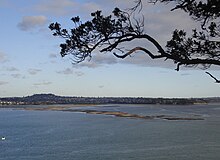Meola Reef




Meola Reef, or Te Tokaroa in Māori ('toka'='rock', 'roa'='long'),[1] is a lava flow forming a reef peninsula across part of Auckland's Waitemata Harbour, New Zealand. The reef extends for over 2 kilometres across the harbour, to within 500 metres of Kauri Point on the northern shore.[2][3]
Geography and natural history
The reef was formed more than 28,000 years ago from the final portion of an 11 kilometre lava flow that originated from Mount Saint John volcano. Until 2008 it was believed the lava had flowed from Te Tatua-a-Riukiuta volcano, but geochemical analyses that year revealed that the lava matched that of Mount Saint John. The route of the lava flow had been disguised by Maungawhau / Mount Eden, which had later erupted through it.[4]
Located between the Point Chevalier and Westmere suburbs and protecting the calm waters of Coxs Bay, the reef is easily seen in the west from the Auckland Harbour Bridge at low tide, when much of it lies exposed. The best viewpoint is at Kauri Point, the headland to the east of Kendall Bay. The portion of the reef close to shore is covered by mangroves, and further out the rocks are covered by rock oysters, then bare. Strong footwear is needed to walk on the lava.
History
The reef had two traditional names to Tāmaki Māori: Te Tokaroa ("The Long Reef") and Te Ara Whakapekapeka a Ruarangi ("The Perplexing Pathway of Ruarangi").[1] The reef was home to Spirobranchus fanworms until the 1960s, when Pacific oysters began displacing the fanworms.[1] In the 1970s, plans for a Second Harbour Crossing from the reef to Birkenhead were shelved after public outcry.[5]
Meola Reef was the site of the city's tip for many years.[6] This has now been capped[7] and replaced by a 15 ha public reserve, with mangrove swamps in the streams and tidal salt marshes either side.[8][9]
In the 1990s, a local community effort to plant native trees on the reserve began. Since its establishment as a reserve, much of the Meola Reef became a fully fenced off-leash dog park.[10][11]
References
- ^ a b c Cameron, Ewen; Hayward, Bruce; Murdoch, Graeme (2008). A Field Guide to Auckland: Exploring the Region's Natural and Historical Heritage (Revised ed.). Random House New Zealand. p. 195. ISBN 978-1-86962-1513.
- ^ Homer, Lloyd; Moore, Phil; Kermode, Les (2000). Lava and Strata: A Guide to the Volcanoes and Rock Formations of Auckland. Landscape Publications Ltd. ISBN 0-908800-02-9.
- ^ Kermode, Les (1992). Geology of the Auckland Urban Area. Institute of Geological & Nuclear Sciences. ISBN 0-478-07000-4.
- ^ Hayward, Bruce W.; Murdoch, Graeme; Maitland, Gordon (2011). Volcanoes of Auckland: The Essential Guide. Auckland University Press. ISBN 978-1-86940-479-6.
- ^ Dearnaley, Mathew (30 May 2009). "Agency in no hurry to replace bridge with harbour 'tubes'". The New Zealand Herald. Retrieved 23 October 2011.
- ^ Annexure B – Contaminated Sites, City of Auckland – District Plan – Isthmus Section – Operative 1999. Retrieved 17 March 2008.
- ^ Pollution of Western Bays Beaches – Going, Going, Gone (from a City Vision press release, 27 September 2007. Retrieved 17 March 2008.)
- ^ Meola Reef (from an image entry of the Te Ara: The Encyclopedia of New Zealand. Retrieved 17 March 2008.)
- ^ Waitematā Harbour – Natural features (from Te Ara: The Encyclopedia of New Zealand. Retrieved 17 March 2008.)
- ^ Pasley, James (15 September 2017). "Residents concerned over possible changes to Meola Reef Reserve". Stuff. Retrieved 29 September 2022.
- ^ "Dogs in the city: Off-leash hotspots". OutAuckland. Auckland Council. 31 December 2021. Retrieved 29 September 2022.
External links
- Photographs of Meola Reef held in Auckland Libraries' heritage collections.
